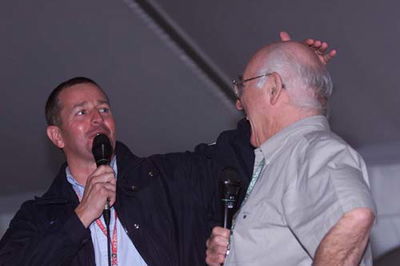Four figures to determine Renault weekend.
When Formula One engineers arrive at a given circuit, they do so armed with a database of facts and figures that allow them to evaluate the performance of their cars and devise an appropriate set-up for qualifying and the race.
Those figures are termed 'sector sensitivities' and detail how different factors affect the car's performance in the three sectors of the circuit. While the engineers study many different parameters, however, the four primary factors remain the key areas of downforce, drag, grip and engine power.
When Formula One engineers arrive at a given circuit, they do so armed with a database of facts and figures that allow them to evaluate the performance of their cars and devise an appropriate set-up for qualifying and the race.
Those figures are termed 'sector sensitivities' and detail how different factors affect the car's performance in the three sectors of the circuit. While the engineers study many different parameters, however, the four primary factors remain the key areas of downforce, drag, grip and engine power.
This weekend's Brazilian Grand Prix takes the circus to Interlagos, a track with two similar sectors comprising a long straight and few corners - sectors one and three - and a much twistier middle sector, which accounts for roughly half the total lap time.
Sector one begins at the timing line, and includes three corners - T1 taken in second gear at around 95kph, T2 taken at just under 160kph in third, and T3 which is exited at around 240kph onto the short back straight where the sector finishes. The sector portion of the layout includes eight of the circuit's twelve corners, which range from T5 taken flat out at 240kph to T10, which is taken at just under 80kph. The final sector begins between T11 and T12 and comprises only one real corner and the uphill acceleration out of the turn, through a number of flat out kinks, back to the timing line.
"When setting up the car at Interlagos, we must balance overall lap time with sufficient speed along the pit straight so that we can overtake other cars and also protect our position," Renault's engineering director Pat Symonds explains, "In general, we aim to achieve a maximum speed of approximately 320kph at the end of the pit straight. However, if we choose to alter this top speed, then the sector sensitivities allow us to calculate the impact this will have on our overall lap-time. This can be illustrated by looking at two extreme settings.
"For example, if we were to reduce our top speed along the straights by between 5-8kph by using more downforce, then the simulations show we would lose only a few thousandths of a second in lap time, but the way this loss would be derived is very interesting. The change would lose 0.06secs in S1 and 0.15secs in S3, owing to the two straights, but gain back 0.2secs in S2 through the numerous corners.
"At the other extreme, if we were to reduce downforce in order to improve our straightline speed by 10kph, then we would lose 0.25secs over the complete lap - losing just 0.005secs and gaining 0.15secs in S1 and S3 respectively, but losing a very significant 0.4secs in S2. Lower downforce settings bring benefits in straightline speed and lap-time in S1 and S3 respectively, but come at the price of a high time penalty in S2. Altering downforce levels always involves balancing gains and losses owing to the increase or decrease in parasitic drag that this inevitably brings."
When examining the contrasting nature of the circuit's sectors, it appears logical that an increase in grip would bring its main benefit in the second sector, which has the highest number of corners. A theoretical five per cent increase in grip - which is much larger than could be found by switching between two raceable tyre compounds - would see overall lap time reduced by 1.25secs, with 60 per cent of this improvement - 0.75secs - coming in the second sector. That is three times the gain obtained in the first and third sectors. Contrastingly, increased engine power would bring greater benefits in the first and third sectors, as a rise of five per cent - around 45bhp - would provide gains of 0.2secs in S1 and S3, and just over 0.1secs in S2.
But why are the figures so useful to the engineers during a race weekend?
Essentially, they provide the basis for comparing performance between the team's cars and their competitors. The team will know roughly where its level of performance is relative to that of its competitors, and can therefore evaluate any differences in speed or lap time using the figures. For example, if it is very quick in S2 and not in S1 and S3, with low straightline speeds, then it can deduce that it may be running too much downforce. If those speeds are competitive, however, and the team remains extremely quick in terms of overall lap time, then it would indicate that it is running a lower fuel load than its rivals.
The database of performance sensitivities provides the race engineers with the reference points they require to make informed choices as they search for the most competitive and race-able set-up.
For the engine-builder, the most notable characteristic of Interlagos is that the circuit is located approximately 700m above sea-level, meaning that atmospheric pressure, which is usually situated at around 1000 millibars, is reduced to around 920.
For any atmospheric engine, this reduction brings with it an inevitable loss in power as, for a given volume of air, the percentage of oxygen - and therefore the potential for effective combustion - is lower. At Interlagos, the engine loses approximately eight per cent of its total power from the basic atmospheric pressure and the humid conditions often encountered at the Brazilian circuit can also have an additional negative impact on performance.
In terms of layout, the circuit includes no very slow corners - the slowest of them, turn ten, is taken at around 80kph. This means that the engine is not used at very low revs and that good levels of torque between 80-220kph are important to launch the cars out of the many corners in the twisty second sector. Equally, the cars need to be able to change direction quickly and effectively while accelerating in that sector. As such, an engine which responds quickly and predictably to the driver's throttle inputs is an important advantage, as is smooth power delivery in order to maintain car balance.
"In order to perform effectively, a strong torque curve must be combined with good levels of traction, particularly on the exit of turn twelve," Renault engine guru Denis Chevrier confirmed, "Obtaining this good traction is complicated by the notoriously bumpy track surface in Brazil. As well as making life difficult for the drivers under braking, by de-stabilising the car, the bumps can cause the rear wheels to lose contact with the track, thus potentially inducing over-revs while the car is under hard acceleration. This means that the safeguards implemented to prevent over-revs are particularly important at this circuit in order to ensure good engine reliability."
Finally, the small number of high-speed corners, coupled with the reduced engine power caused by the atmospheric conditions and the relatively short lap, means that both fuel consumption - 2.4kg per lap - and the time penalty for carrying extra fuel - 0.27secs - are both comparatively low - both values are located below the season averages of 3kg and 0.37secs respectively.











